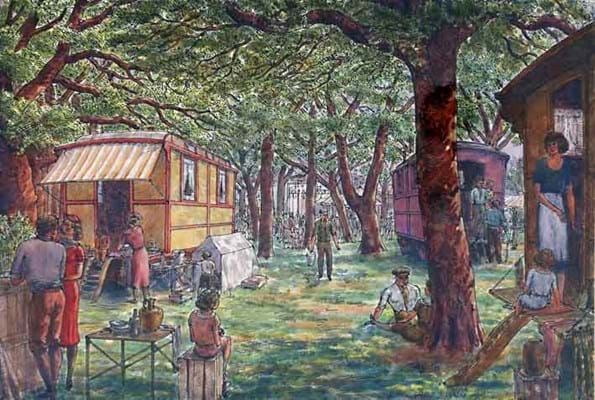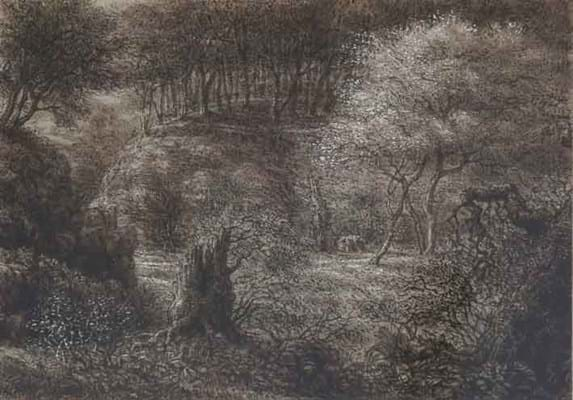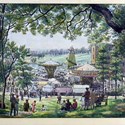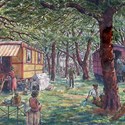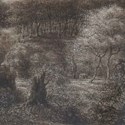While the former approach is often necessitated by the practicalities of having to store the items otherwise, the staging and promotion of a studio sale can also garner special attention in the artist that might not otherwise emerge.
At best these events offer an important body of work and provide an opportunity to survey the artist's entire range and career. They may even contain some of the best pictures which the painter deliberately held back or couldn't bear to part with.
In fact, if this is the case, it is not unknown for these sales to set a major new benchmark in terms of an artist's market - think back to the Robert Lenkiewicz studio sale at Bearne's in 2003 for example.
Most recently, this occurred at Gloucestershire auctioneers Chorley's (18% buyer's premium) when they dispersed the studio collection of the artist Gerald Ososki (1903-81).
Over 100 works were consigned by his grandson to the auction at the Prinknash Abbey rooms on July 23-24. These pictures had remained with the family although his estate had earlier provided around 70 lots of predominantly Italian Old Master drawings to a Bruton Knowles sale in May 1987.
There was a real mixture in terms of medium, subject and quality, but all the works were attractively estimated and they duly met with an impressive response. There were also a number of pictures that clearly shone out.
Multi-Talented Artist
Born in London's East End, the son of a struggling tailor, Ososki left school aged 14 and worked as a draughtsman designing war memorials and inscribing them with names of the dead. He then managed to gain a place at the Royal College of Art in the early 1920s after the principal, Sir William Rothenstein, secured a grant which allowed him to study full-time.
Living and working in Hampstead for most of his life, he found employment as an interior decorator for cinemas and theatres in the 1930s and, during the Second World War, he became an accomplished camouflage artist.
Furthermore, he was a leading figure in the conservation of historic buildings after the war including St James's Palace, Clarence House, Lancaster House and the Gold and White State Ballroom at Buckingham Palace.
In terms of the pictures he produced over the course of his career, there were landscape paintings, portraits and detailed pen and watercolour studies - all of which were represented at the current sale.
Remaining friends with Rothenstein, he would visit his mentor's Cotswolds home on numerous occasions and his son later moved to Gloucestershire himself (hence the connection to the Chorley's saleroom).
Incidentally, an oil of the Rothensteins' Oakridge farm made £450 here.
While Ososki was associated with his contemporaries at the Royal College such as Henry Moore, Barbara Hepworth and Edward Burra, he has never had anything like the recognition of these major names in 20th century British art. Commercially, he has also had little exposure, with the auction record before the current sale being the £550 paid at Christies in 1991 for a watercolour of the fair on Hampstead Heath.
Here at Chorley's, the bar was raised almost six-fold as a strong reaction in particular was generated by his 1930s pictures of scenes from this North London location.
'Ready to Hang'
In displaying the works to potential clients, the auctioneers decided to arrange the works like a 'gallery viewing' and this appeared to generate some extra interest from people who were not necessarily familiar with the artist's work but found these pictures attractive and decorative. The fact that they were in good clean condition and nicely framed lent them additional appeal as being 'ready to hang'.
On the day, there was some trade interest but it was mostly private bidding that saw 96 of the 107 Gerald Ososki lots get away for £27,275. The artist's previous record was exceeded eight times here, starting with the second lot of the sale - a watercolour, Bathers at the Pool, Hampstead Heath, which realised £650.
Fairground Scenes
The most notable factor in the bidding was that the works that drew the highest demand combined the Hampstead subject matter with a strong sense of the period in which they were painted - the two fairground scenes that sold to private buyers and set two of the highest prices in the collection being a case in point.
Fair on Hampstead Heath, a 14¼x 22in (36 x 56cm) ink and watercolour, was a colourful view overlooking the setting which was signed and dated 1932.
As well as being a panorama over the heath with plenty of figures, it also had an element of social history depicting the Easter and Bank Holiday fun fairs which started back in the late 19th century and were celebrated in Albert Chevalier's song Oh 'Ampstead and in Phil May's 'Appy 'Ampstead' cartoons. Estimated at £400-600, it sold for £2000.
The same was true of At the Fair, Hampstead Heath which was from the same year and in the same medium and similarly sized at 14 x 22in (36 x 56cm). However, it provided a rather different sense of the same event, being an on-the-ground view with scattered figures and fairground wagons under the shaded trees.
Estimated at £300-400, it drew determined bidding and was eventually knocked down at £3200, the highest picture price of the sale and the new benchmark for Ososki.
With the new market levels established at this sale, even a drawing went beyond the previous saleroom high when Clearing in a Wood, a 12½ x 18in (32 x 47cm) sanguine chalk and brush drawing which was signed and dated 1954, overshot a £150-200 estimate and was sold for £850.



